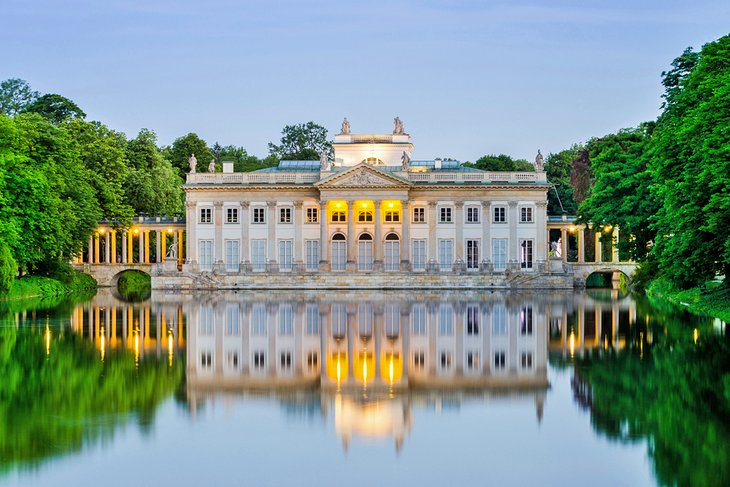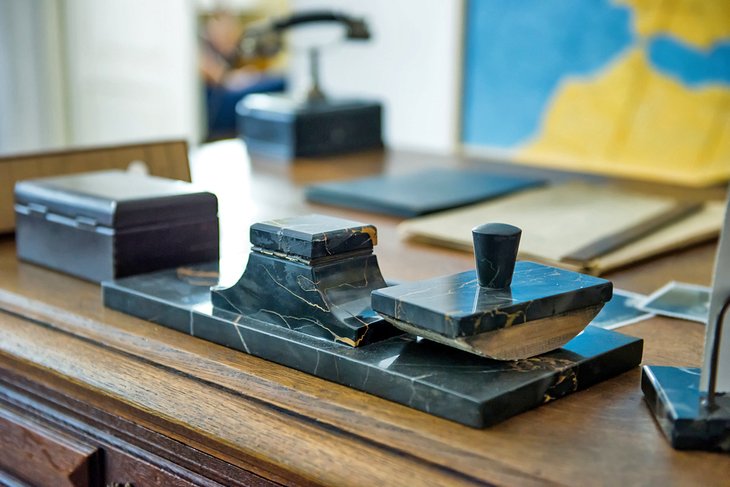Poland!
Top-Rated Tourist Attractions in Poland
Poland is a historical country with 14 UNESCO World Heritage Sites and a collection of breathtaking natural corners — mountains, national parks, rugged coastlines, and some unexpected natural wonders such as the world's oldest salt mine.
With its medieval architecture, troubled WWII history, and many villages that seem to be stuck in time, Poland is the perfect destination for history buffs and architecture lovers. Poland's cities are humming with the energy of art and culture and are a great starting point to discover everything the country has to offer.
No matter if you're after history, art, or nature, plan your visit with our list of the top tourist attractions in Poland.
1. Wieliczka Salt Mine, Wieliczka

The 13th-century Wieliczka salt mine is just as important for the locals today as it was hundreds of years ago, but for a very different reason. One of the world's oldest and longest-working salt mines, it stopped commercial operations in 1996 and has since become an artistic attraction.
The Wieliczka Salt Mine is now home to four chapels, corridors, and statues — all carved out of the rock salt walls. The mine's original shafts and passageways — some as deep as 327 meters underground — have been reopened and allow visitors to explore pits and chambers, walking past statues and alongside stunning architectural marvels. Deep into the mine, an underground lake shimmers against the candlelit walls.
The main tourist attraction inside the mine, however, is the Chapel of St. Kinga, a 12-meter-high chamber where everything — including the elaborate chandeliers and furniture — are made of salt. The tour continues on to the Erazm Baracz Chamber, where you'll find a lake that's saltier than the Dead Sea, and ends at a museum that explains salt mining and what life in the mines was like.
2. Auschwitz-Birkenau Camps, Oswiecim

The Auschwitz I and the Auschwitz II–Birkenau concentration camps are a different kind of must-see. Located about an hour west of Krakow, the camps offer a sobering look into the past.
Between 1942 and 1944, over 900,000 Jews were brought to the camps here from German-occupied countries. Political prisoners, Roma, and a number of other ethnicities were also sent here. Less than 10 percent of the people brought here survived their stay.
At the end of the war, as Soviet forces advanced into Poland, the Nazis destroyed the gas chambers and crematoria before fleeing. Although they managed to destroy and burn down part of the camp, many structures remain standing to this day.
The camps, which include over 300 barracks and hundreds of other buildings and crematoriums, can only be explored as part of a guided tour.
Official site: http://auschwitz.org/en/
3. Warsaw Old Market Place, Warsaw

The oldest part of Warsaw, the Old Town Market Place dates back to the 13th century. Although 85 percent of the area was destroyed by the Nazis during World War II, it has since been restored to look exactly like it did when it was first built.
A mix of medieval architecture, Gothic, and colorful Renaissance buildings and merchant houses all coexist in the city's most popular square. The 19th-century bronze statue of a sword-wielding mermaid — a symbol of Warsaw's since medieval times — survived the War and still stands at the square.
Today, the Market Square is home to many cafés and restaurants, as well as street art sellers and many souvenir stalls. The main branch of the Historical Museum of Warsaw is also located here — home to a massive art collection but also a look through the history of the city and country.
The Adam Mickiewicz Museum of Literature, just steps away, pays homage to Poland's most famous poet and writer.
4. Malbork Castle, Malbork

This 13th-century Teutonic castle was originally built by the Teutonic Knights, a religious order that served as a crusading military unit. Although the castle started as a small fortification, it was subsequently expanded over the centuries and eventually became a massive structure. Once the largest Gothic building in Europe, Malbork castle remains the world's largest castle by land area.
Today, the castle serves as a museum, with many of its original rooms perfectly preserved. Highlights include a medieval kitchen with a six-meter-wide fireplace, a collection of armor and weapons, and the knights' private toilet at the top of a tower.
In addition to historical collections, the castle also houses a number of exhibits, including one showcasing the conservation techniques used to restore the castle.
5. Lazienki Park, Warsaw

Lazienki Park covers 76 hectares of the city center, making it one of Poland's largest urban parks. Lazienki started life as a baths park for a nobleman in the 17th century. Today, the Palace on the Isle is open to the public, as are the gardens around it.
A Classical-theater isle stage (where performances are still held), a number of smaller palaces and structures that now serve as museums or galleries, and even a classicist temple dedicated to the goddess Diana are set in the gardens.
A large statue of classic Polish composer Frederic Chopin stands on the grounds of the park as well. The statue was purposely destroyed by German forces as they invaded Poland during WWII and reconstructed in 1958 using the original mold. Every Sunday afternoon, free piano concerts are held at the foot of the statue.
6. Schindler's Factory, Krakow

Oskar Schindler's enamel and metal factory — made famous by Steven Spielberg's 1994 movie — is now home to two museums. Part of the building has been converted into the Museum of Contemporary Art, while Schindler's former office — and much of the former factory floor — is now a branch of the Historical Museum of the City of Krakow.
Schindler's former office, which has been preserved intact since War times, is now an exhibit dedicated to his life and the lives of the people he saved in this very factory. In the office, a wall of glass known as the "Survivors' Ark" serves as a time capsule, full of enamel pots like the ones built at the factory.
The rest of the factory presents a number of cinematic exhibits that show Krakow during the War and the impact the Nazis had on the history of the city and the lives who inhabited it. There are also a number of immersive stage-like reconstructions of 1940s spaces — from a typical street to the seats of a tram to a typical Jewish apartment of the time.
7. Crooked Forest, Gryfino

Located just outside the tiny town of Gryfino, the Crooked Forest is a (perhaps) natural marvel that defies explanation. Here, a number of pine trees stand on their own, growing with a 90-degree angle at their base, all bent northward.
The pines were originally planted here in the 1930s, but it took about 10 years before the trunks started to show their characteristic bent. Despite many theories, there's a standing heated debate on whether the curvature was created artificially by manipulating the trees — or whether it just happened naturally or accidentally.
Regardless of the cause, the eerie presence of the trees is hard to deny, especially as the rest of the forest is full of healthy, perfectly straight pine trees. It's a great place for a quiet hike in the silence of the forest.
8. Warsaw Rising Museum, Warsaw

This is a museum dedicated to 1944's Warsaw Uprising, where the Polish Underground Resistance fought the German occupation of their city. The uprising lasted for 63 days, with massive casualties on both sides.
Once the Polish forces surrounded them, the Nazis systematically destroyed a large number of historical buildings and structures in retaliation. The uprising was a massive effort by a poorly equipped and barely armed group of civilians trying to defeat the enemy — and the museum has done a remarkable job of bringing that spirit to life.
Exhibits here include many rooms and events brought to life through films, artifacts, recreations, and interactive displays, including replicas of the sewer tunnels used to move around the city in secret, an insurgent hospital, and a print shop where you can see posters and underground newspapers.
Several rooms show continuous original footage of the events, and there's a special section dedicated to the Nazi occupation and the atrocities committed during the uprising.
9. Wawel Royal Castle, Kraków

Wawel is an architecturally eclectic castle — the construction has medieval elements mixed with Baroque and Renaissance details. One of the first places to be declared a UNESCO World Heritage Site in Poland, the castle has always been an important part of the history of the country.
King Sigismund I the Old, who lived in the castle in the 16th century, was an avid collector of art — so it makes sense that the castle is now an important art museum, focused mainly on paintings and curatorial work.
Additional collections include weapons and armor, porcelain and ceramics, lots of textiles and prints, and a significant amount of period furniture. The museum also has an unusually large collection of Ottoman tents, the largest of its kind in Europe.
10. Wolf's Lair, Gierloz

Hitler's top-secret military headquarters is hidden deep in the Masurian woods. When it was active, it had three fortified security areas around it, defended by land mines in addition to heavily armed units.
At the time, the area included over 80 buildings, including several air-raid shelter bunkers and watchtowers. The Nazis blew up the complex in 1945 before fleeing the approaching Soviet Forces, but some of the buildings were so heavily reinforced, many of them could not be destroyed.
Visitors can now make their way to the area as a day trip from Warsaw. Although there are plans to eventually add historical exhibits or even a museum to the area, for now it's more a collection of ruins to walk through, discovering the corners of the history that developed here.
11. Morskie Oko Lake, Tatra National Park

Located deep within the Tatra National Park and surrounded by towering mountains and Swiss pines, the lake is a favorite destination for people of all ages. Reaching it requires an easy but long paved hike through shaded forests. The lake changes color throughout the year, transforming from a deep shade of blue to a softer turquoise hue.
The Tatras National Park extends through both Poland and Slovakia. In Poland, it's home to over 600 caves; snow-covered peaks; and a number of waterfalls, including the 70-meter-tall Wielka Siklawa.
Most of the park is hikeable, with over 270 kilometers of trails of all lengths and difficulties.
12. Kraków Cloth Hall, Krakow

The Hall, which dates back to the Renaissance, has always been the heart of international trade in Poland. During the 15th century, it was the main place for foreign merchants to gather to sell exotic spices from the East.
Traders from all over Europe also came here to buy salt from the Wieliczka Salt Mine. Textiles, leather, and silk were also traded here — imported from other countries for sale and produced locally.
The Hall was renovated in the 19th century and used for years as an events center, where formal balls to honor visiting emperors and kings were held. The main floor is now again a center of commerce, with small stalls and galleries selling souvenirs, collectibles, and small pieces of art.
The Sukiennice Museum has taken over the second floor — home to a large collection of 19th-century Polish art.
(thanks to: www.planetware.com)
Comments
Post a Comment